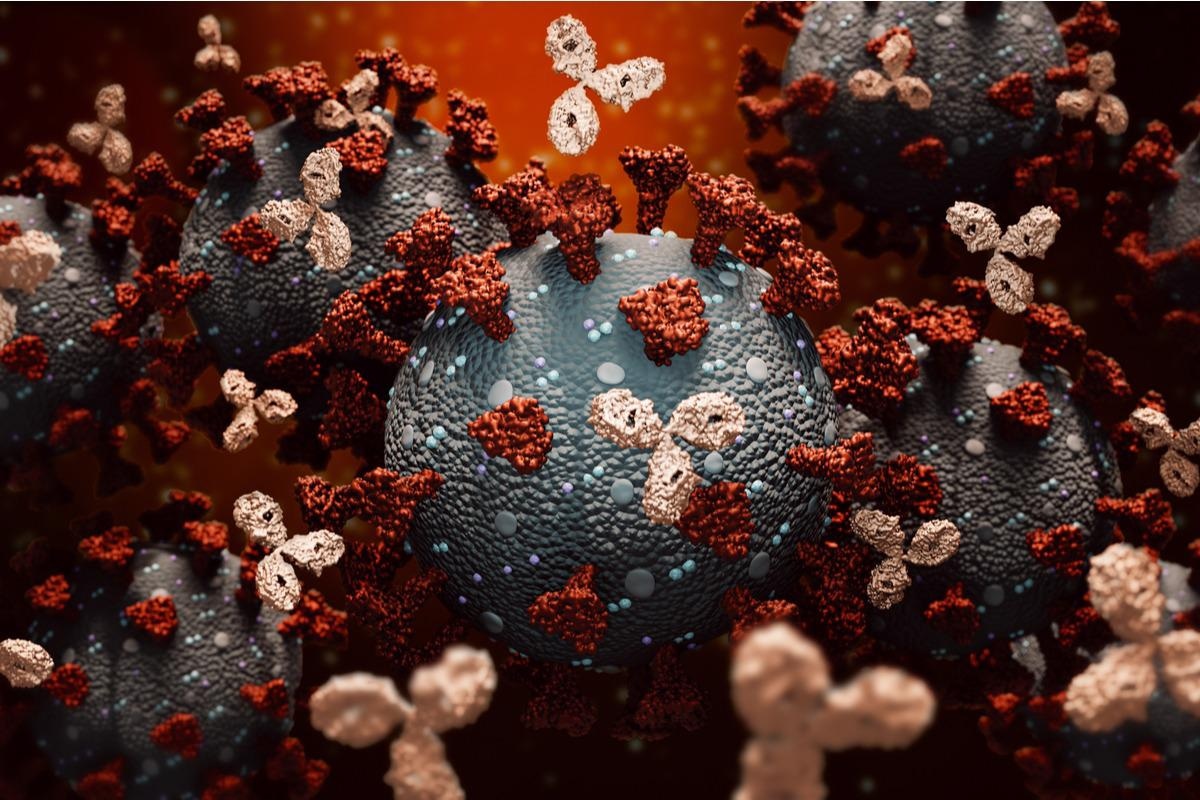In a recent study posted to the bioRxiv* preprint server, researchers evaluated the efficacy of viral spike domain 2 (S2)-specific human monoclonal antibodies (hmAbs) delivered intranasally, against all beta coronaviruses (β-CoV) in hamsters and mice. Additionally, they analyzed the mAb humoral response against several severe acute respiratory syndrome coronavirus 2 (SARS-CoV-2) variants of concern (VoCs).
 Study: Potent universal-coronavirus therapeutic activity mediated by direct respiratory administration of a Spike S2 domain-specific human neutralizing monoclonal antibody. Image Credit: MattLphotography/Shutterstock
Study: Potent universal-coronavirus therapeutic activity mediated by direct respiratory administration of a Spike S2 domain-specific human neutralizing monoclonal antibody. Image Credit: MattLphotography/Shutterstock

 This news article was a review of a preliminary scientific report that had not undergone peer-review at the time of publication. Since its initial publication, the scientific report has now been peer reviewed and accepted for publication in a Scientific Journal. Links to the preliminary and peer-reviewed reports are available in the Sources section at the bottom of this article. View Sources
This news article was a review of a preliminary scientific report that had not undergone peer-review at the time of publication. Since its initial publication, the scientific report has now been peer reviewed and accepted for publication in a Scientific Journal. Links to the preliminary and peer-reviewed reports are available in the Sources section at the bottom of this article. View Sources
Background
SARS-CoV-2 variants demonstrated increased viral transmission due to mutations in the receptor-binding domains (RBD) and N-terminal domains (NTD) of their component spike (S) glycoprotein. Alterations at the S domains, S2 and S1, enhance viral binding with human angiotensin-converting enzyme 2 (hACE2) receptors and membrane fusion, which facilitates immune evasion.
Although several vaccines have been developed, their efficacy against the novel variants is low. To this end, hmAbs have been investigated as therapeutic strategies against coronavirus disease 2019 (COVID-19). Previous studies have established the beneficial effects of S1-specific mAbs.
About the study
In the present study, the researchers assessed the efficacy of several S2-specific mAbs delivered intranasally against all β-CoVs and several SARS-CoV-2 VoCs such as Beta, Gamma, Delta, Epsilon, Omicron, and Urbani. In addition, the synergistic action of the S1-specific 1213H7 and S2-specific 1249A8 mAbs was also assessed.
Blood was collected from convalescent COVID-19 patients a month following polymerase chain reaction (PCR)-confirmed COVID-19 diagnosis. SARS-CoV-2 S2-specific potent human memory B cells were isolated from the blood samples and identified using recombinant fluorescent proteins such as S2-STBL (stabilized SARS-CoV-2) and S1S2 (SARS-CoV S1 and SARS-CoV-2 S2). These B cells were sorted into single cells and stained by flow cytometry, after which hmAbs were generated. The Fc effector function and neutralization capacity of the S2 hmAbs were assessed by antibody-dependent cellular phagocytosis (ADCP) analysis and live virus- and pseudovirus-based neutralization assays, respectively.
The K18 human ACE2 transgenic mice were used to assess the prophylactic activity of 1249A8 hmAb. Mice were treated with either a single dose of 1249A8 intraperitoneally (IP), and 12 hours later challenged with both rSARS-CoV-2 WA-1 and rSARS-CoV-2 Beta or a combination regimen with a modest dose of S1-RBD specific 1213H7 (5 mg/kg) mAb. Based on the broad neutralizing β-CoV activity of 1249A8 in mice, the team assessed its therapeutic potency in hamsters when administered directly into the respiratory tract. Syrian hamsters were immunized with SARS-CoV-2 Delta, and 12 hours p.i. they were immunized intranasally with one dose of hmAb. Additionally, to assess pan β-CoV therapeutic activity, hamsters were infected with the SARS-CoV Urbani strain.
Results
Although four mAbs effectively neutralized live and pseudovirus against Beta and Delta VoCs, the hmAb 1249A8 emerged as the most potent and broad hmAb, effective against all human β-coronaviruses and neutralized Middle Eastern respiratory syndrome (MERS-CoV), SARS-CoV, HKU-1 seasonal β-CoV, and OC43. It protected hamsters from weight loss, with therapeutic activity further enhanced when combined with 1213H7.
1249A8 and 1213H7a demonstrated a 4.2-fold and ~8-fold greater ADCP activity than the controls, respectively. The combinational treatment with 2 mg/kg 1213H7 and 8 mg/kg of 1249A8 maintained the weight and significantly reduced nasal viral titers and lung pathologies in mice and hamsters. The synergistic beneficial effects were more pronounced when the hmAbs were administered directly to the respiratory tract through intranasal (i.n.) delivery. Additionally, 1249A8 demonstrated substantial somatic hypermutation with 16.7% and 7.6% amino acid mutation in the heavy and light chain variable regions, respectively. The 1249A8 binding epitope was localized to S2 residues 1131-1171.
Conclusion
These study findings showed that the 1249A8 hmAb was the most potent S2-specific hmAb with universal activity against all β-CoV and SARS-CoV-2 variants in mice as well as hamsters.
Moreover, the combination of 1249A8 with S1-specific hmAb 1213H7 demonstrated enhanced therapeutic efficiency in terms of reduced nasal viral titers, increased neutralization capacities against all β-CoV, and SARS-CoV-2 variants decreased pathologies in the lower and higher respiratory tracts, and the prevention of weight loss in the animals. These effects were most pronounced when the combinational mAbs were administered intranasally, directly into the respiratory route.
The 1249A8 and 1213H7 mAb cocktail would especially benefit the immunocompromised and vaccine-reluctant individuals by providing long-term and efficient universal passive immunization. Further studies assessing more mAbs and their neutralization effects against specific viral strains must be carried out for faster clinical translation of mAb therapeutics to prevent and control COVID-19.

 This news article was a review of a preliminary scientific report that had not undergone peer-review at the time of publication. Since its initial publication, the scientific report has now been peer reviewed and accepted for publication in a Scientific Journal. Links to the preliminary and peer-reviewed reports are available in the Sources section at the bottom of this article. View Sources
This news article was a review of a preliminary scientific report that had not undergone peer-review at the time of publication. Since its initial publication, the scientific report has now been peer reviewed and accepted for publication in a Scientific Journal. Links to the preliminary and peer-reviewed reports are available in the Sources section at the bottom of this article. View Sources